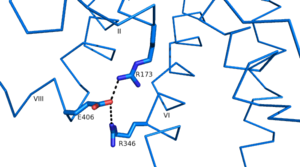Sandbox Reserved 1167
From Proteopedia
(Difference between revisions)
| Line 8: | Line 8: | ||
== Background == | == Background == | ||
[[Image:7tm_labeled_with_membrane.png|200 px|left|thumb|The 7tm spans the cell's membrane]]The human glucagon receptor (GCGR) is one of 15 secretin-like, or Class B, G-protein-coupled receptors (GPCRs). Like other GPCRs, it has a <scene name='72/721538/7tm_labeled_helicies/3'>7 trans-membrane </scene> helical domain (shown in blue) and a globular N-terminus <scene name='72/721538/Ecd/2'>extracellular domain</scene> (shown in magenta). As its name suggests, the 7tm is made up of alpha helices that pass through the membrane seven times. The Extracellular Domain has a α-β-β structure which consists of two antiparallel β-sheets and an N-terminal α-helix<ref>PMID:26227798</ref>. | [[Image:7tm_labeled_with_membrane.png|200 px|left|thumb|The 7tm spans the cell's membrane]]The human glucagon receptor (GCGR) is one of 15 secretin-like, or Class B, G-protein-coupled receptors (GPCRs). Like other GPCRs, it has a <scene name='72/721538/7tm_labeled_helicies/3'>7 trans-membrane </scene> helical domain (shown in blue) and a globular N-terminus <scene name='72/721538/Ecd/2'>extracellular domain</scene> (shown in magenta). As its name suggests, the 7tm is made up of alpha helices that pass through the membrane seven times. The Extracellular Domain has a α-β-β structure which consists of two antiparallel β-sheets and an N-terminal α-helix<ref>PMID:26227798</ref>. | ||
| - | |||
| - | |||
== Function == | == Function == | ||
| Line 44: | Line 42: | ||
An important interface stabilization interaction between helices I and VII occurs between [https://en.wikipedia.org/wiki/Serine Ser] 152 of Helix I and Ser 390 of Helix VII. Due to their close proximity to one another, they form an important <scene name='72/721537/Ser-ser_hydrogen_bond/2'>hydrogen bond</scene> which serves to stabilize the structure of GCGR. | An important interface stabilization interaction between helices I and VII occurs between [https://en.wikipedia.org/wiki/Serine Ser] 152 of Helix I and Ser 390 of Helix VII. Due to their close proximity to one another, they form an important <scene name='72/721537/Ser-ser_hydrogen_bond/2'>hydrogen bond</scene> which serves to stabilize the structure of GCGR. | ||
| - | |||
| - | |||
== Glucagon Binding == | == Glucagon Binding == | ||
| Line 54: | Line 50: | ||
This transition mechanism is consistent with the "two-domain" binding mechanism of Class B GCPRs in which (1) the C-terminus of the ligand first binds to the ECD allowing (2) the N-terminus of the ligand to interact with the 7tm and activate the protein. | This transition mechanism is consistent with the "two-domain" binding mechanism of Class B GCPRs in which (1) the C-terminus of the ligand first binds to the ECD allowing (2) the N-terminus of the ligand to interact with the 7tm and activate the protein. | ||
| - | |||
| - | |||
| - | |||
== Clinical Relevance == | == Clinical Relevance == | ||
Revision as of 18:16, 29 March 2016
| This Sandbox is Reserved from Jan 11 through August 12, 2016 for use in the course CH462 Central Metabolism taught by R. Jeremy Johnson at the Butler University, Indianapolis, USA. This reservation includes Sandbox Reserved 1160 through Sandbox Reserved 1184. |
To get started:
More help: Help:Editing |
Class B Human Glucagon G-Protein Coupled Receptor
| |||||||||||
References
- ↑ Hanson, R. M., Prilusky, J., Renjian, Z., Nakane, T. and Sussman, J. L. (2013), JSmol and the Next-Generation Web-Based Representation of 3D Molecular Structure as Applied to Proteopedia. Isr. J. Chem., 53:207-216. doi:http://dx.doi.org/10.1002/ijch.201300024
- ↑ Herraez A. Biomolecules in the computer: Jmol to the rescue. Biochem Mol Biol Educ. 2006 Jul;34(4):255-61. doi: 10.1002/bmb.2006.494034042644. PMID:21638687 doi:10.1002/bmb.2006.494034042644
- ↑ Yang L, Yang D, de Graaf C, Moeller A, West GM, Dharmarajan V, Wang C, Siu FY, Song G, Reedtz-Runge S, Pascal BD, Wu B, Potter CS, Zhou H, Griffin PR, Carragher B, Yang H, Wang MW, Stevens RC, Jiang H. Conformational states of the full-length glucagon receptor. Nat Commun. 2015 Jul 31;6:7859. doi: 10.1038/ncomms8859. PMID:26227798 doi:http://dx.doi.org/10.1038/ncomms8859
- ↑ PMID:PMC4321206

